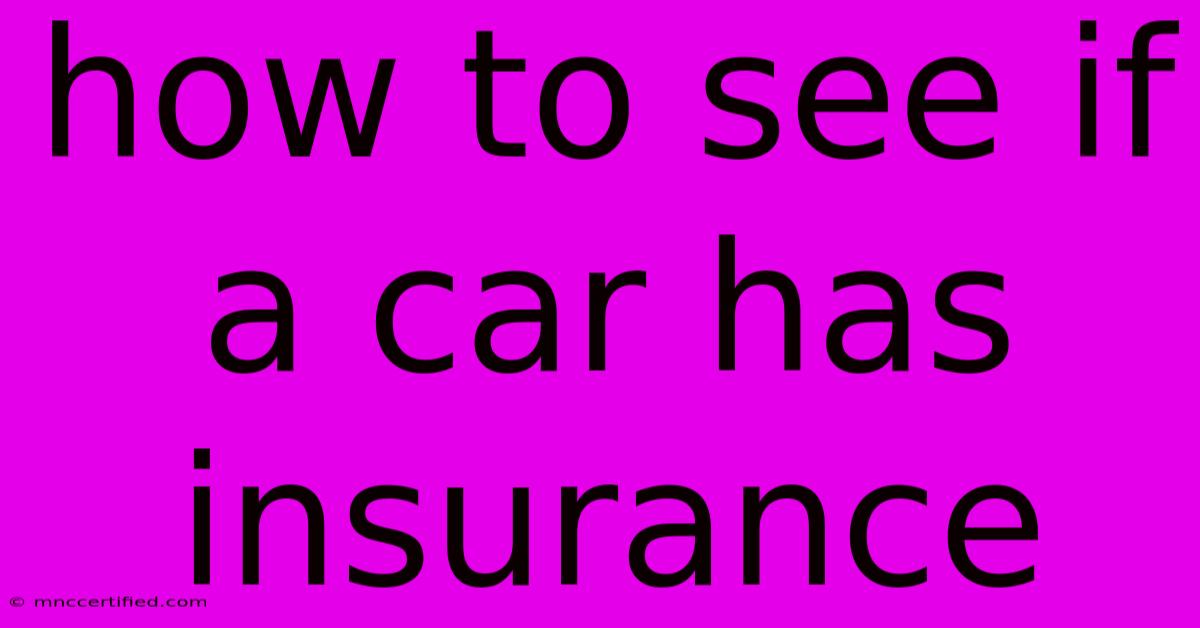How To See If A Car Has Insurance

Table of Contents
How to See if a Car Has Insurance: A Comprehensive Guide
Knowing whether a car is insured is crucial for various reasons, from your own safety after an accident to verifying the legitimacy of a potential purchase. This comprehensive guide will walk you through several methods to determine if a vehicle has valid insurance coverage. We'll cover everything from readily available online tools to more involved investigative steps.
Why is it Important to Know if a Car is Insured?
Before diving into the "how," let's understand the "why." Knowing a car's insurance status is vital in several scenarios:
- After an Accident: If you're involved in a collision, confirming the other driver's insurance is paramount. An uninsured driver can leave you financially responsible for damages and medical bills.
- Buying a Used Car: Purchasing a vehicle from a private seller? Verifying insurance history offers peace of mind and helps avoid potential future headaches.
- Rental Car Insurance: Understanding if a rental car is appropriately insured is critical to avoiding costly out-of-pocket expenses in the event of an accident.
- General Safety: In some regions, proof of insurance is required for registration. Checking insurance status can provide insight into a vehicle's overall legality and history.
Methods to Check if a Car Has Insurance
Unfortunately, there isn't a single, universally accessible database revealing every car's insurance status. However, several methods can help you determine if a vehicle likely has insurance:
1. Ask the Driver/Owner Directly
The simplest method is to politely ask the driver or owner for proof of insurance. This is often the most effective and straightforward way to obtain the necessary information. Requesting to see their insurance card or a digital copy is perfectly acceptable.
2. Check the Vehicle's Registration and License Plate
State-Specific Requirements: Some states mandate that proof of insurance be displayed on the vehicle's registration or license plate. This isn't a universal practice, though, so success depends on location. Check your state's Department of Motor Vehicles (DMV) website for specific rules.
Note: Even if insurance is listed on the registration, it doesn't guarantee current coverage. The policy may have lapsed.
3. Use Online Resources (Limited Availability)
While a centralized national database doesn't exist, some states offer online tools or portals that allow access to limited insurance information. However, these usually require additional data like the vehicle identification number (VIN) or license plate. Your success depends heavily on your state's regulations and data sharing policies.
Keyword Search: Use search terms like "[Your State] car insurance verification" or "[Your State] DMV insurance records" to find relevant resources.
4. Contact Your Insurance Company
If you're involved in an accident, your insurance company might be able to help verify the other driver's insurance status. They have access to various databases and may be able to assist in the investigation.
5. Hire a Private Investigator (Last Resort)
This is a costly and time-consuming option and should only be considered as a last resort. A private investigator may be able to uncover more information, but it’s generally unnecessary for most scenarios.
Legal Considerations and Privacy
It’s important to remember that accessing someone's insurance information without proper authorization can be illegal. Stick to the methods outlined above, which are generally considered acceptable ways to gather information.
Conclusion: Proactive Steps for Peace of Mind
Verifying a car's insurance status can be challenging, but by utilizing a combination of these methods, you can significantly increase your chances of confirming coverage. Remember, always prioritize your safety and act responsibly when seeking this information. Proactive steps, like requesting proof of insurance directly, can go a long way towards ensuring peace of mind.

Thank you for visiting our website wich cover about How To See If A Car Has Insurance. We hope the information provided has been useful to you. Feel free to contact us if you have any questions or need further assistance. See you next time and dont miss to bookmark.
Featured Posts
-
Prophecy Review Dune Sisterhoods Darkness
Nov 19, 2024
-
Brendan Carrs Post Fcc Chapter Next Steps
Nov 19, 2024
-
Watch Croatia Vs Portugal Uefa Nations Live
Nov 19, 2024
-
Broncos Offense Nix And Paytons Synergy
Nov 19, 2024
-
Russia Threatens Response To Us Missiles
Nov 19, 2024